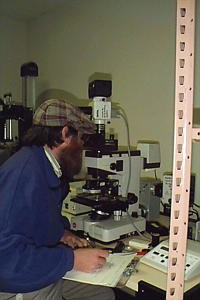14 November, 1998
November 14, 1998
THE LABWORK FROM THE PAST FEW DAYS
For a few days it was pretty frustrating because the gill cells
were not looking like they should have. The DASPEI stain that was
injected into the fish should have made the chloride cells glow green.
But when I looked in the microscope, I couldn't find any chloride
cells, although I could find a lot of glowing other cells. Some of
these were football-shaped cells which looked like parasites, or
perhaps cysts of parasites waiting to become activated by the right
conditions. One of the fish had up to 35 of them in each field of
view (at 400 X magnification) in 75% of the gill filaments. That's a
pretty heavy parasite load! Some of these cells glowed much more
brightly than the others. This suggests that there were more
mitochondria in them. Maybe they were activated and getting ready to
develop into parasites. Three of the five fish I observed also had
flatworms related to Planaria crawling around in their gills. That was
interesting but I felt sorry for the fish, although otherwise the fish
seemed healthy and perky until they were killed (so I could study the
gills). Ed said that when he dissects the fish to use their kidneys
for his experiments, he has noticed other parasites like worms in
different organs all over their bodies. He said he never wants to eat
one of these fish because he would be grossed out by the thought of
eating those parasites. Dr. Smith jokingly responded, "But think of
all that extra protein you'd be getting"!
Another neat thing I saw when I looked at the gills was the blood
still flowing through the blood vessels in the gill filaments, even
though the gills had been removed from the body several minutes
before. Fish blood cells are different from ours. They have a
nucleus (which ours lack) and they are shaped more like two pyramids
stuck together at the base. Trematomus bernacchii has red blood just
like we do because in its red blood cells it has hemoglobin, the
protein that carries oxygen. But some of the fish in Antarctica, the
icefish, lack hemoglobin.
QUESTIONS TO THINK ABOUT: 1. All fish cells need oxygen so their
mitochondria can work to make ATP, the molecule that provides energy
for the cells to work. Why would it be adaptive for a fish to lack
such an important protein? (Hint: think about energy conservation.
Also think about blood viscosity.)
2. If the icefish lack hemoglobin how can they get enough oxygen
to all the cells in their bodies?
3. Even though they don't have hemoglobin, the icefish do have
some red blood cells (though much fewer in number). What do you think
they have red blood cells for if they lack hemoglobin?
BACK TO THE RESEARCH
Finally we wondered if the concentration of DASPEI was too low
so the chloride cells were not getting stained by it. To find out, we
doubled the dosage yesterday and it worked like a charm. I am now
excited about my project and the procedures are becoming routine.
Everything seems to be working out all right. Today, the second day
with the new technique should be the test. If it works well, I think
I will be able to come up with some good data to determine whether or
not fish in warmer water (about 4 degrees Celsius) have more chloride
cells or bigger chloride cells than the fish in the normal sea water
(-1.86 degrees Celsius). Then it will all get down to doing the
mechanics of the counting and the measuring.
Well, I'd better go get lunch so I can start my afternoon work on
schedule. Sierra injected the DASPEI into the live fish at 9:45 this
morning. The DASPEI has to be flowing in the blood for 3 hours so she
will harvest the gills for me at 12:45. At 12:15 I will drive the
pick-up truck down to the old aquarium, put the fish in a cooler of 4
degree water, and bring it back up to the lab for her work on.
OH I ALMOST FORGOT
I found a great website about Weddell Seals. You can see photos, hear
their sounds, and read about the research being done by them. Since
their research is conducted right around here and their camp is near
our fish hut by Cape Evans, their maps show the location of many of
the areas I have mentioned. The address is
http://siniff3.ecology.umn.edu
OK, I hope you have a good day and do something good for someone.
Fred Atwood
_________________________________________________________
DO YOU YAHOO!?
Get your free @yahoo.com address at http://mail.yahoo.com

Mr Atwood uses high quality photomicroscopy equipment to photograph the fluorescent chloride cells from the gills of a fish in the Crary lab at McMurdo Station.
Contact the TEA in the field at
.
If you cannot connect through your browser, copy the
TEA's e-mail address in the "To:" line of
your favorite e-mail package.
|
